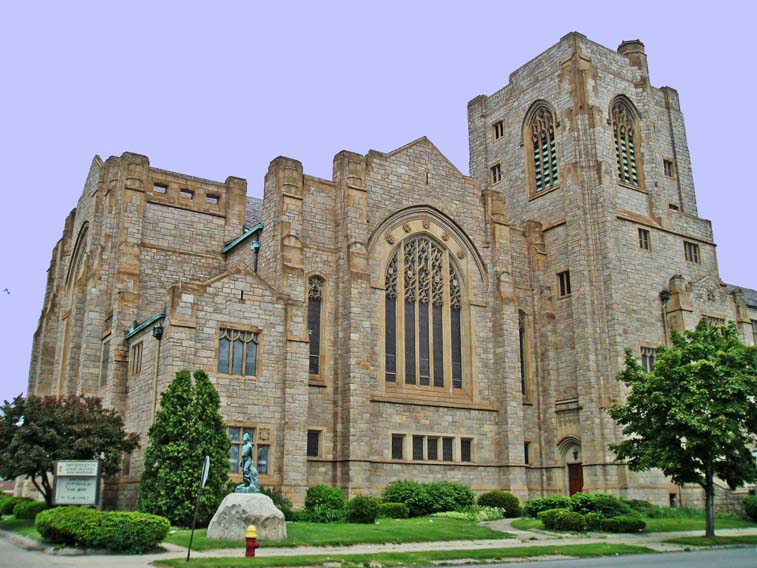

If you had doubts about the significance of religion in the Motor City, they would disappeared if you walked the city’s main thoroughfare all the way from Cadillac’s landing spot out to Highland Park. Lower Piety row extends along Woodward from Gordon Lloyd’s Central United Methodist at Grand Circus Park to Malcomson and Higginbotham’s Our Lady of the Rosary Catholic (formerly St. Joseph’s Episcopal) at Woodward and the Edsel Ford Freeway.
The imposing structure that you see in this picture is the southernmost house of worship in Detroit’s Upper Piety Row, a row that extend as far north as United Methodist located at 13100 Woodward in Highland Park.
Central United Methodist began building their impressive structure during the Civil War. As Detroit’s population grew and prospered in the late Nineteenth Century, Central United helped initiate other Methodist churches to serve those Methodists who did not live near Grand Circus Park. Two of these developing Methodist churches, Woodward Avenue Methodist Episcopal founded in 1885 and Oakland Avenue Church dating from 1886, merged to form North Woodward Avenue Methodist Church in 1901. Two years later, the entrepreneurial and successful Dr. Charles Bronson Allen became pastor. The prosperity of the congregation allowed them to build an impressive large church on Melbourne very near the church you see but, alas, fire consumed the structure on Christmas Eve in 1916.
Pastor Allen, realizing the prosperity and fervor of his members, decided to build an extremely impressive church, one of the largest Methodist churches in the country. Fortunately, a member of the congregation, Sebastian Kresge, who lived nearby in his mansion at the northwest corner of West Boston and Woodward, generously supported the project. Indeed, he purchased the valuable property at Woodward and Chandler and gave it to the church. A member of the congregation, William E. N. Hunter, served as architect. Hunter specialized in designing ecelastical structures. His legacy includes St. Josephat Roman Catholic Church on East Canfield; Historic Trinity Evangelical Lutheran on Gratiot at the Eastern Market and the impressive Grosse Pointe Memorial Church on Lake Shore Drive.
Hunter built a very large structure in the English Gothic style, with much attention to historical detail. It is a traditional cruciform design buttressed with several low side wings and a gabled roof. The color of the church is distinctive since Hunter chose ochre granite mined in Massachusetts. Perhaps, it was challenging to design a house of prayer that would be distinguished from the many church and two synagogues that lined Detroit’ piety rows. Hunter succeeded in building a memorable and unique church.
This congregation prospered. By 1956, just before the movement of Detroit residents to the suburbs accelerated, this church served 7,000 members, making it, I believe, the largest Methodist congregation in Michigan. The church continues to fulfill the needs of its members. It is also the site of one of the four Cornerstone schools now located in Detroit. This is a chain of non-profit ecumenical but Christian schools founded by the leader of the Detroit Catholic diocese, Adam Cardinal Maida, whose impressive Blessed Sacrament Cathedral, is located just a couple of blocks to the northwest along Woodward.
Architect: William N. E. Hunter
Date of Construction: 1926
Architectural Style: English Gothic
Material: Ochre Massachusetts granite
City of Detroit Local Historic District: Not listed
State of Michigan Registry of Historic Places: P 25,174. Listed October 23,
1986
State of Michigan Historical Marker: None put in place yet
National Register of Historic Sites: Listed August 3, 1982
Website: www.metroumc.org
Use in 2013: Methodist church
Picture: Ren Farley; May, 2005
Description updated: February, 2013